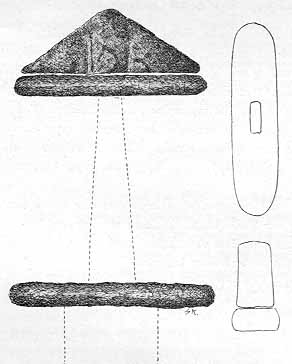

The [upper and lower] guards are low with strongly curved, even ridged sides. The cross-sections are evenly wide and rounded at the ends. The pommel is also evenly wide, three-sided, narrower than the guards, and in a couple of cases divided into three segments, and in one case also divided into seven segments (B 6845: Neri, Opstryn s., Stryn, Nordfjord). One specimen from Trøndelagen (T 64) has a segmented pommel with three divisions. The guards are close to type H, they are wider, although not of this type entirely. The specimen resembles to a large degree C 21704, pictured under type H (fig. 84). Overall, these types affect each other.
Type A is poor, simple, and does not make a strong impression with its low guards of ordinary length, and with its thin pommel. The guards are without a metal covering, the pommel has not been attached to it [the upper guard] with rivets, only by sticking the shaft through and flattening it at the end of the pommel. 8 specimens have been found of this type. In addition we have T 64 from Trøndelagen. In 4 of the specimens only the guards are preserved. Other parts may not have been placed in the grave either.[1] Of the remaining 4, 3 have double-edged [blades] and 1 has a single-edged blade. Neither of the blades are damascened or have inscriptions. They are narrow, and among the smaller of the blades from the Viking Age. [59]
I list the 8 specimens below:
| 1. C 2039. | Sander, Kraakstad, Akh. |
| 2. C 20931a. | Bjertnes, Krødsherred, Sigdal, Busk. |
| 3. Skiens mus. 2720. | Nordheim, Hedrum, J.L. |
| 4. B 936. | Helleve, Vangen s. Voss, S.B. |
| 5. B 2755 - 62 | Prestegaarden, Voss, S.B. |
| 6. Nord. mus. 18724. | Fortun, Lyster, N.B. |
| 7. B 6845. | Nesi, Opstryn s. Stryn, N.B. |
| 8. T 1937. | Vigten, Nærø, N.T. |
As one can see, the distribution is wide, and not tied to a particular region of the country [Norway]. The type is lacking in the south-western part of the country, but the material is so limited that this factor, for the time being, has little significance.
Of the other items found together with swords of this type, are axes of type A and B, and also an ax that is close to type D. Of shields, there are pieces of R 564 in one find. Besides, in one of the finds, there appears a single-edged sword without hilt (C 20931, Bjertnes, Krødsherred).
It will become evident that the type is very old, especially the aforementioned find from Krødsherred which must be from the 7th Period [of the Iron Age]. However, the ax close to type D points to the fact that the type extends beyond the transition into the Viking Age.
I do not know this type outside of Norway. It is surely a plain simplification of sword pommels from the older Iron Age; but I shall not point to a particular prototype. It must be said however, that there is great similarity with, for example, the sword depicted in Praehistorische Zeitschrift VI, p. 154, fig. 57f. This depicted sword is from Finland. [60]
[1] See Schetelig's comment in Bergens museums aarbok 1908 nr. 3, p.42, nr. 97 a. [return]